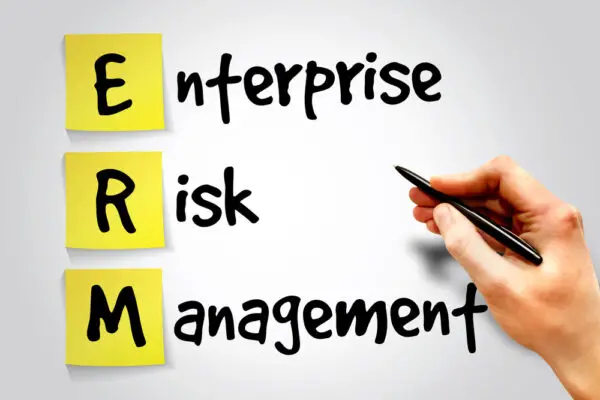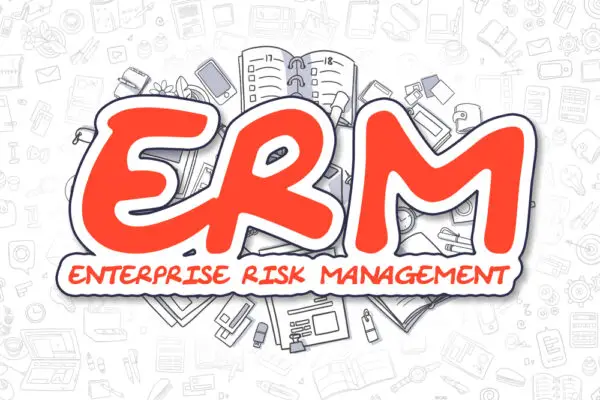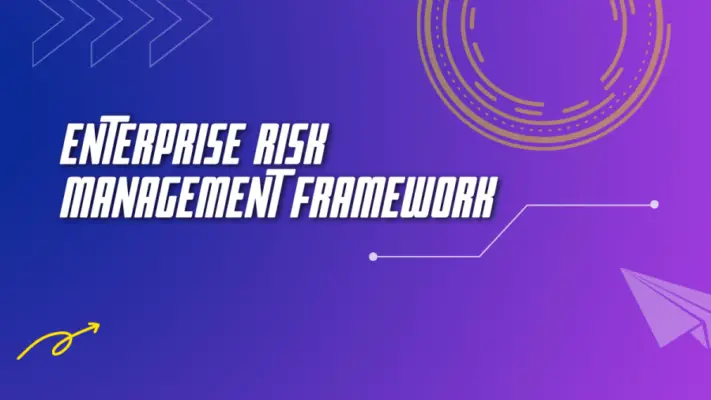Enterprise Risk Management(ERM) provides organizations with a systematic approach to identifying, assessing, prioritizing, and managing risks across the enterprise.
Enterprise risk management (ERM) helps organizations identify and manage potential risks that could prevent achieving strategic goals and objectives.
Despite its importance in today’s business landscape, ERM is often misunderstood.
Some view it as a compliance exercise or an unnecessary cost rather than a strategic tool for driving performance.
However, implementing ERM correctly can benefit organizations by increasing their resilience in times of uncertainty and helping them make better-informed decisions about allocating resources effectively.
This article will provide an overview of enterprise risk management and its importance in today’s business environment.

Definitions of ERM
Enterprise Risk Management (ERM) is a holistic approach that considers all types of risks facing an organization, including financial, operational, strategic, and reputational risks.
ERM aims to reduce downside risk while benefiting from upside risk by identifying potential threats and opportunities.
The importance of ERM lies in its ability to provide a comprehensive understanding of an organization’s risk profile. This allows organizations to make informed decisions that align with their strategic objectives while meeting legal and regulatory obligations.
Risk categories in ERM include compliance, financial reporting, legal/regulatory compliance, operational efficiency, reputation/brand damage, and strategic risks. Understanding these categories is essential for developing a successful ERM framework.
In ERM, legal and regulatory obligations are critical, as non-compliance can lead to significant financial losses or reputational damage. A proper understanding of these obligations is necessary for meeting compliance requirements.
Accountable individuals at every level within the organization should ask important questions about their organization’s ERM framework to ensure it meets legal requirements while providing effective risk management solutions.
Benefits and Misconceptions
Implementing an enterprise risk management (ERM) framework effectively can increase organizational resilience and agility and improve decision-making processes.
ERM considers all types of risks an organization may face, including strategic, operational, financial, and reputational risks. Proactively identifying and managing these risks, organizations can reduce downside risk and benefit from upside risk.
However, some common misconceptions about ERM may hinder an organization’s ability to identify and manage potential risks. One such misunderstanding is the belief that a one-size-fits-all solution exists for risk management.
Each organization is unique in size, complexity, industry sector, and risk appetite.
Another misconception is that ERM only focuses on avoiding negative outcomes or preventing losses. While minimizing downside risk is important in any organization’s risk management strategy, ERM also provides opportunities for growth by identifying potential areas of opportunity and innovation.
To fully realize the benefits of ERM, organizations must understand the categories of risk involved in their operations and the legal and regulatory obligations they must meet.
Risk categories include strategic risks related to achieving business objectives, operational risks associated with day-to-day activities, and financial risks related to investments or capital structure.
Compliance risks associated with meeting regulations and laws; reputational risks associated with public perception; environmental or social responsibility-related issues; political or legal uncertainties, among others.
Understanding these categories helps organizations prioritize which areas require the most attention when developing their ERM approach.
Effective integration into organizational culture leads towards assured compliance while providing enhanced decision-making processes, thus driving performance, sustainability, and growth through proactive identification and mitigation of emerging threats rather than reactive responses after incidents occur.
Process and Categories
Enterprise risk management involves continuously identifying potential risk exposures that could prevent an organization from meeting its strategic goals and objectives.
To achieve this, formal ERM frameworks such as COSO ERM and the principles of ISO 31000 are available, which help organizations customize their risk strategy framework based on their business and risk appetite.
Organizations need to be aware of different categories of risks, including:
- Strategic risks relate to factors outside the control of the organization or those arising from internal decision-making processes.
- Operational risks are associated with day-to-day activities related to production processes or delivery mechanisms.
- Financial risks pertain to uncertainties in funding sources and investment decisions.
- Compliance risks arise from legal or regulatory requirements imposed on organizations to ensure adherence to specific standards or industry-specific regulations.
- Reputational risks relate to negative publicity from any adverse event affecting an organization’s image.
Understanding the process and categories of enterprise risk management is essential for organizations seeking a mature and embedded approach to effectively managing their exposure levels.
Businesses can identify potential vulnerabilities early on while developing targeted responses tailored to mitigate these challenges effectively.
Customized approaches facilitate successful implementation by providing a clear roadmap for effective communication with stakeholders about managing these potential downside effects while maximizing opportunities for growth through innovation and sustainability efforts.

Lines of Defence
The Three Lines of Defence approach is a critical component of enterprise risk management (ERM). It provides a framework for effectively managing risks and ensuring they are appropriately identified, assessed, monitored, and controlled.
This approach involves three lines, each having different responsibilities but working together to achieve effective risk management.
The first line includes operational managers responsible for identifying and managing risks on a day-to-day basis. They are usually the ones closest to the risks and are primarily responsible for managing them.
The second line includes compliance, assurance, and risk management functions that provide oversight to ensure the risks are managed effectively.
The third line comprises internal audit or external auditors who provide independent assurance over the effectiveness of risk management processes.
Mature and embedded risk management require all three lines to work together seamlessly to achieve successful risk management.
Clearly defining roles and responsibilities across all levels in an organization ensures that potential risk exposures are identified early on before they escalate into significant issues that could prevent meeting strategic goals and objectives.
Effective ERM facilitates enhanced decision-making by providing flags or markers to avoid potential trouble while complying with legal and regulatory obligations at every stage.
i3 Australia
i3 Australia’s approach to effective risk mitigation, challenging conventional thinking and driving performance through innovation, growth, and sustainability.
i3 Australia recognizes the importance of enterprise risk management in organizations and emphasizes that proper implementation can drive organizational success. The company believes that every organization is different, so differences in ERM across organizations must be considered.
i3 Australia’s approach to risk management involves embedding it at every level of the business. This means that mature and embedded risk management must exist throughout all aspects of an organization to successfully dialling up risks.
The company believes that by doing so, businesses can be assured of taking advantage of the Risk/Reward proposition while still complying with legal and regulatory requirements.
i3 Australia challenges conventional thinking about risk management and believes that properly implemented ERM can drive performance while supporting innovation, growth, and sustainability.
Through recognizing the differences in ERM across organizations and embedding them at every level of the business, companies can successfully mitigate risks while taking advantage of growth opportunities.
Frequently Asked Questions
What are some common challenges organizations face when implementing ERM?
Organizations often face several common challenges when implementing Enterprise Risk Management (ERM).
One of the primary issues is a lack of understanding or awareness of ERM’s benefits and importance, which can result in resistance to change and difficulty in gaining buy-in from key stakeholders.
Additionally, organizations may struggle with identifying all potential risks, including emerging ones, and establishing a risk appetite aligning with their strategic objectives.
Another challenge is integrating ERM into day-to-day operations effectively, including ensuring accountability at all levels of the organization and embedding risk management practices into decision-making processes.
Finally, monitoring and reporting risks can be complex and time-consuming without a robust framework to track progress towards risk mitigation goals. Overcoming these challenges requires a comprehensive approach that includes education.
Also, effective communication strategies, strong leadership support for ERM initiatives, ongoing training for employees at all levels of the organization, and continuous improvement efforts to refine ERM processes over time.
What is the role of internal audit in Enterprise Risk Management?
The role of internal audit in enterprise risk management involves providing independent and objective assurance of the effectiveness of the organization’s risk management activities.
Internal auditors assess whether risks are being identified, evaluated, and mitigated appropriately and provide recommendations for improvement where necessary.
They also monitor the implementation of risk management strategies to ensure they remain effective over time.
In addition to assessing risks within the organization, internal auditors may also evaluate external factors that could impact the business, such as regulations or economic conditions.
How does ERM differ across various industries and sectors?
Enterprise risk management (ERM) differs across various industries and sectors due to each organisation’s unique risks. Implementing ERM requires organizations to identify, assess, monitor, and manage risks impacting their ability to achieve strategic objectives.
While some risks are common among organizations, such as financial, operational, legal and regulatory compliance, others may be specific to an industry or sector.
For example, a healthcare organization may have specific patient safety and data privacy risks, while a manufacturing company may face supply chain disruptions or environmental concerns.
The key is for organizations to understand the nature of their risks and implement an ERM framework customized to their business model and risk appetite.
Can ERM be effective for small businesses as well as large corporations?
Enterprise risk management (ERM) can be effective for small and large corporations. ERM considers all types of risks and reduces downside risk while benefiting from upside risk.
This approach is often misunderstood, and legal and regulatory obligations must be met to implement it properly.
Successful risk management includes compliance, assurance, and enhanced decision-making, allowing organizations to take advantage of the Risk/Reward proposition.
The Three Lines of Defence approach is key to embedding risk management into the organization, and it must be mature and embedded at every level of the business for successful dialling up risks.
While i3 Australia challenges conventional thinking about risk management, properly implementing ERM can drive performance and support innovation, growth, and sustainability in both small and large corporations.
How does ERM help organizations in crisis management situations?
Enterprise Risk Management (ERM) helps organizations manage crises by providing a framework for identifying, assessing, and mitigating risks before they become crises.
ERM allows organizations to anticipate potential disruptions and develop strategies to minimize the impact of these events. This approach helps organizations build resilience in times of crisis by enabling them to respond quickly and effectively to unexpected challenges.
ERM also enables organizations to learn from past crises and improve their risk management processes in the future.
How does ERM integrate with other business functions like finance and operations?
ERM considers all types of risks, including financial, operational, strategic and reputational. It reduces downside risk and benefits from upside risk while helping to meet legal and regulatory obligations.
A proper understanding of ERM is necessary for accountable people in organizations to ask important questions about the level of risks their business faces.
Successful risk management includes compliance, assurance, and enhanced decision-making, allowing organizations to take advantage of the Risk/Reward proposition. The Three Lines of Defence approach is key to embedding risk management into the organization at every level to successfully dialling up risks.
What role do employees play in successful ERM implementation and maintenance?
Employees are the first line of defence against risks and must be aware of their roles in identifying, assessing, and mitigating risks within their areas of responsibility.
It is essential to provide employees with adequate training to understand the ERM framework, its objectives, and how it aligns with the organization’s goals. Effective communication about ERM policies and procedures should also be maintained throughout the organization.
A culture that supports risk identification and management can lead to an embedded ERM approach that enables a more comprehensive understanding of risks across all levels of the business.

Conclusion
Enterprise risk management (ERM) is crucial to any organization’s success, as it helps identify potential risks that could prevent achieving strategic goals and objectives. This article has clarified the concept of ERM, its benefits, categories of risk, legal and regulatory obligations, and successful risk management strategies.
In understanding the importance of ERM and implementing it properly, organizations can drive performance and support innovation, growth, and sustainability.
Benefits include improving decision-making processes by providing comprehensive information about potential risks, enhancing stakeholder trust by demonstrating effective governance practices, and reducing operational costs through early identification of risks.
Enabling organizations to pursue opportunities confidently. Misconceptions about ERM include equating it with compliance or insurance functions only, not involving key stakeholders, and neglecting to evaluate and adjust strategies regularly.
The ERM process involves identifying potential risks based on organizational objectives and external factors such as economic conditions or regulatory changes.
Categories of risk include strategic risks (such as market competition), financial risks (such as fluctuations in currency exchange rates), operational risks (such as equipment failure or human error), legal/regulatory/compliance risks (such as lawsuits or penalties for non-compliance), reputational/branding risks (such as negative publicity).
Successful risk management strategies involve aligning risk appetite with business strategy, integrating ERM into daily operations rather than treating it as a separate function, and establishing clear lines of communication between different levels within the organization to ensure all stakeholders are informed about identified risks.
Organizations should prioritize investing resources into developing their own customized approach to ERM that suits their specific needs while keeping in mind legal obligations surrounding this area.

Chris Ekai is a Risk Management expert with over 10 years of experience in the field. He has a Master’s(MSc) degree in Risk Management from University of Portsmouth and is a CPA and Finance professional. He currently works as a Content Manager at Risk Publishing, writing about Enterprise Risk Management, Business Continuity Management and Project Management.

